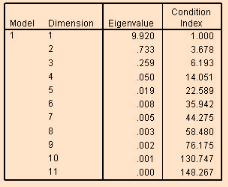A condition index shows the degree of multicolinearity in a regression design matrix. It is an alternative to other methods like variance inflation factors.

Although there’s no generally agreed on method to identifying multicollinearity in data, condition indices give a relatively straightforward way to find potential issues. The indices are widely available in statistical software. For example, SPSS gives a condition index as part of the SPSS Collinearity Diagnostics table found in output.
Kennedy (2003) describes a condition index is the largest to smallest characteristic root of X’X; it’s a measure of how close X’X is the perfect multicollinearity (called singularity). The indices are calculated as “—the square roots of the ratios of the largest eigenvalue to each successive eigenvalue” (IBM Knowledge Center).
Condition indices are sometimes called “condition numbers“, although this can be misleading. More accurately, they are a type of condition number (other types exist for functions, matrices and other specific situations).
Condition Index Interpretation
Kennedy gives the following rule of thumb for interpreting a condition index; Any index greater than 30 “—indicates strong collinearity.” The IBM knowledge center calls values over 30 a “serious problem” and also suggests values greater than 15 may indicate a problem that warrants a closer look.
References
IBM Knowledge Center. Collinearity diagnostics. Retrieved July 23, 2019 from: https://www.ibm.com/support/knowledgecenter/en/SSLVMB_23.0.0/spss/tutorials/reg_cars_collin_01.html
Jackson, S. (2006). Statistics Plain and Simple. Cengage Learning.
Kennedy, P. (2003). A Guide to Econometrics. MIT Press.